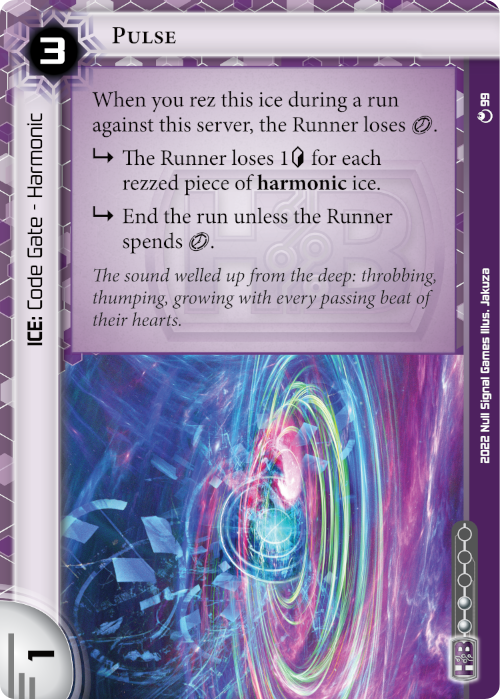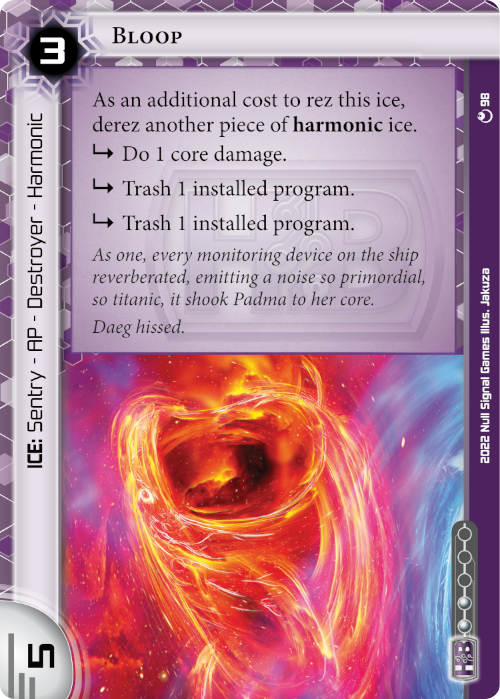Hi, I am ZiNOS, a Game Developer for Null Signal Games since the founding of the organization. I was always an ice person. Since the relaunch of “The best card game ever”™ by FFG, I’ve been fascinated by the design and play patterns of ice; small islands of hidden information everywhere, where the Runner (if they are good enough) knows what to expect, and the Corp (if they are also good enough) tries to subvert the Runner’s expectations.
Ever since I joined the Null Signal Games Dev team, I have actively tried to make and test ice. Let’s say that you can call me the team’s “Ice Guy”. And when I conclude my work for Null Signal Games (hopefully a long time from now), you’ll be able to say “No more Mr. Ice Guy”!
Rotation will eventually move the entire NEXT ice suite out of the card pool, and so it seemed natural that something similar – ice that interacts with each other – should take their place. Where NEXT ice uses quantity as the main scaling factor for improving them (the more NEXT ice, the better they get), the new suite should have something different.
I toyed with the idea of power counters moving between ICE on rez, with servers interacting vertically and horizontally, to no avail and with too much complexity. The idea that stuck was to make the actual sequence in which the ice were rezzed matter. Earlier ice will give bonuses to the later ice, but with some restrictions. Moreover, derezzing and re-rezzing the same ice will allow you to trigger some of its effects again. I came up with some designs for the various factions, an ID to support them, and, after some discussions with former NSG Creative team member Dis, we decided on the subtype name harmonics. We named them after instruments in an orchestra, with each ice subtype corresponding to a different section of the orchestra. Thus, code gates were strings, sentries were brass, and barriers were percussion instruments.
I pitched the idea to Design. We had some available spots in the Haas-Bioroid ice slots, and so HB harmonics were incorporated in the Borealis Cycle. Design did some really excellent work on them, creating some new harmonic ice for HB and incorporating them smoothly within the overarching themes of the cycle. We kept the subtype name since it fit well, but we changed the names of each individual ice, naming them instead after underwater sounds so as to fit with the underwater theme of Thule Subsea in Borealis.
In Midnight Sun, we saw Wave (formerly named Violin), and Echo (formerly named Cymbals). Wave is the major enabler for harmonics, since it will help fetch the rest of the “combo chain”, but is also a great ice tutor in general. Echo is a more basic design, meant to showcase the growth of the harmonics suite and the ability to grow larger if a harmonic ice is derezzed and rezzed again.
However, we kept the “spicier” ones for the second part of the Borealis Cycle.
First, we have Pulse (formerly named Cello):
A harmonic ice that fits the click manipulation mechanic of HB, this card can really make the job of Mr. Hendrik, the new HB Sysop, much easier.
Secondly, we have Bloop (formerly named Horn):
Numbers-wise, the stats on this ice are toned down compared to, say, an Archer, but the subs that really count (program trashing) are still here, combined with a core damage subroutine. A facecheck on a Bloop (accompanied by a snarky comment like “I bloop you for 1 core and 2 trashes”), can be a real setback for the Runner. Once a harmonic ice is rezzed (most preferably a Wave that fetched a copy of Bloop), all face-down ice can now potentially bloop™ the Runner. Only the bravest or most foolish will continue running recklessly!
We hope you’ll have fun playing with the harmonic suite, and making every run in which a harmonic ice is rezzed a nightmare (archive) for the Runner! Thanks for reading, and remember to take care of your ice as well as they take care of your servers!
Parhelion will be released digitally on December 9, 2022, on Jinteki.net and as pay-what-you-want print-and-play files, and, on December 12, 2022, as physical cards via Null Signal Games’s store, our print-on-demand partners, and our authorized resellers.


